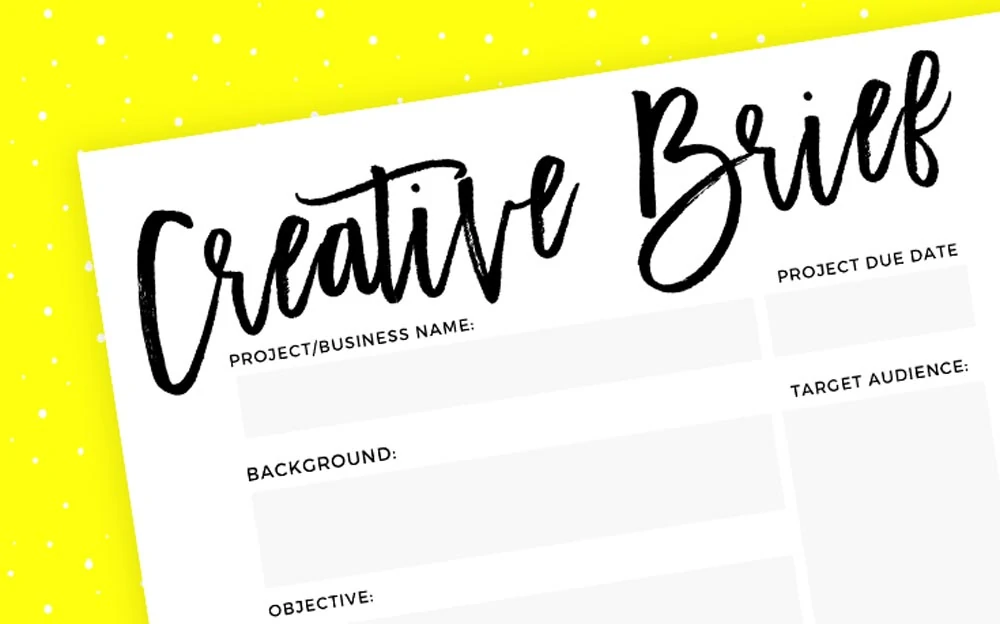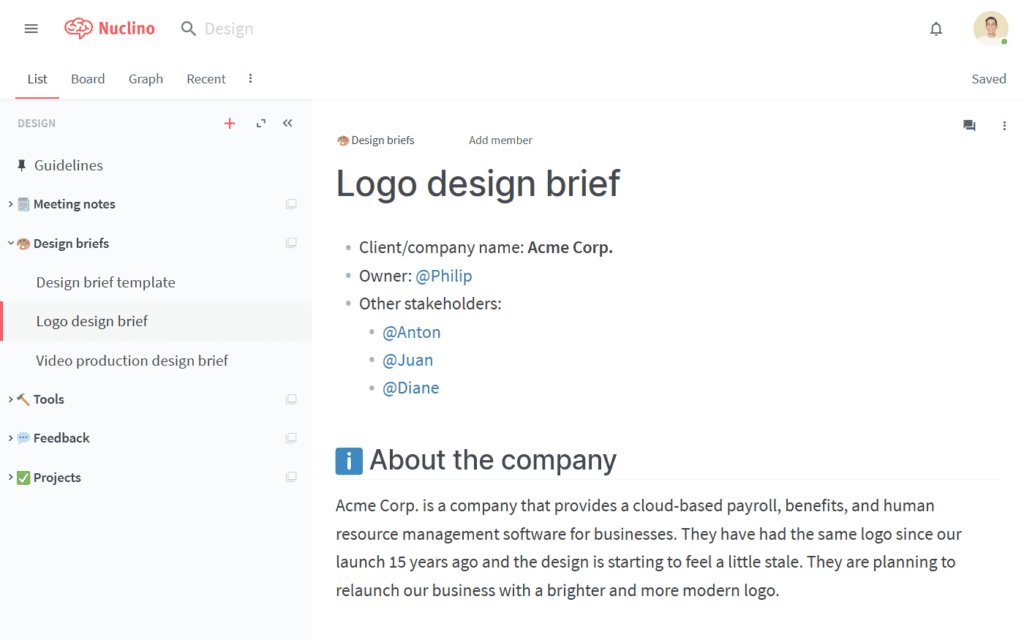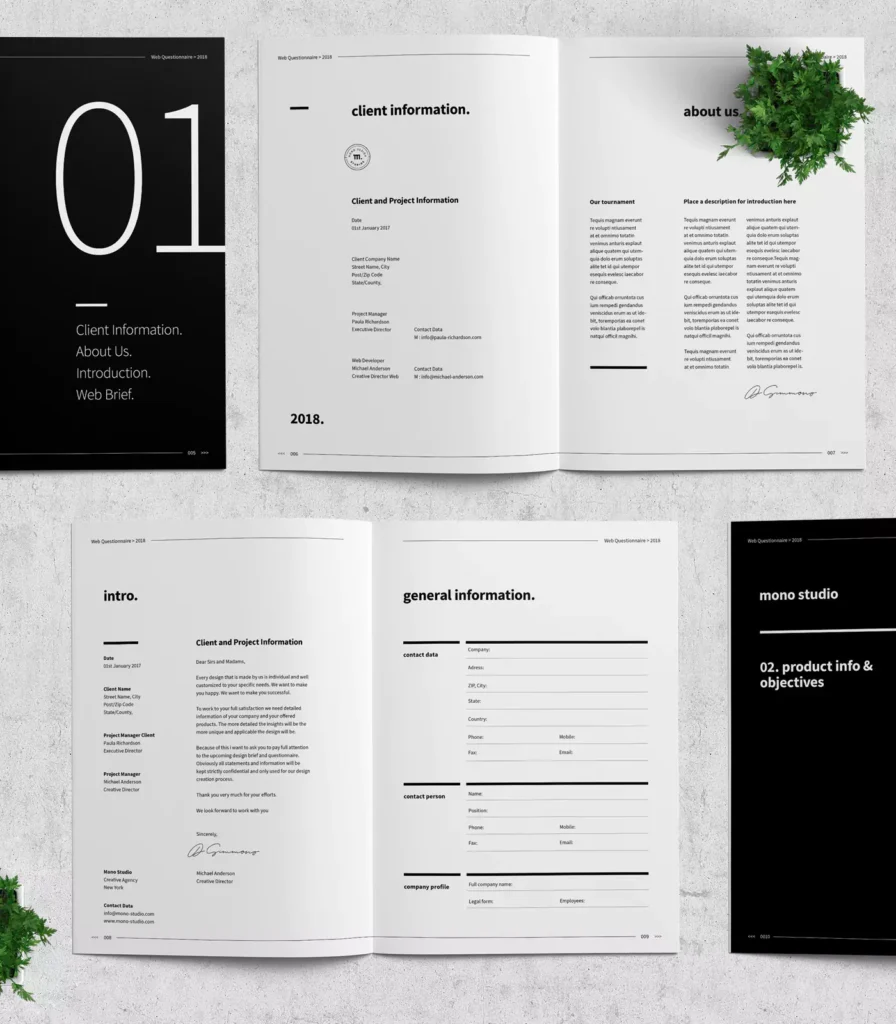How to Write a Graphic Design Brief: 5 Must-Have Elements
A graphic design brief is a document that provides detailed instructions and requirements for a graphic design project. It serves as an agreement between the client and the designer, setting clear expectations about project scope, timeline, budget, and success metrics before work begins.
A design brief is a blueprint that guides the graphic designer's creative process from start to finish. Just as an architect can't build a house without first consulting the client's plans and specifications, a graphic designer can't effectively develop a logo, brochure, website, or other design materials without first understanding the client's goals, target audiences, brand style, technical needs, and further vital details—all of which should be captured in the brief.
Table of Contents
Why Graphic Design Briefs Matter
You're probably wondering—why go to the trouble of creating a formal design brief? Can't I verbally tell my designer what I need or provide a loose description? Here's why taking the time to develop a thoughtful design brief pays off:
- Saves time and money. With clear instructions upfront, designers don't waste effort going down the wrong creative paths or using incorrect brand elements that then require rework.
- Manages expectations. The brief ensures all stakeholders are “on the same page” about what will be delivered and when.
- Drives better results. Designers can tailor their work directly to your strategic business objectives rather than guessing your needs.
- Reduces miscommunications. Unlike verbal conversations, the documented brief minimises confusion about requirements.
- Provides helpful reference. Designers can refer to the brief frequently to ensure they remain on track to serve your goals.
In other words, the upfront investment to create an intense design brief gives clients and designers the clarity, focus, and alignment needed for efficient and successful projects.
Elements of an Effective Graphic Design Brief

Design briefs range from single-page to multi-page documents. But every well-constructed brief contains these key elements:
Project Background
- Goal – What does your business aim to achieve with this design project? Be specific. Example goals: Increase website conversions by 20%. Make our brand identity cohesive across all materials. Educate consumers about our new eco-friendly packaging.
- Objectives – Break down the overall goal into smaller measurable objectives. Example objective: Drive 10% more traffic to our product pages.
- Business/brand overview – Provide brief context about your company, products/services, brand personality and position in the market. Help the designer understand your “why.”
Audience Profile
- Primary/secondary target audiences – Detail demographic and psychographic qualities of who precisely you want to reach. Prioritise primary targets.
- Audience needs/values – What does your audience care about the most? What would compel them to engage with your brand?
- Audience media habits – Where and how does your audience consume information and make decisions? Online? In stores? Word-of-mouth?
Project Details
- Project scope – High-level description of the end design deliverable(s). Example: A tri-fold brochure to distribute at trade shows.
- Timeline – Key project milestones and target completion date.
- Budget – Total available budget and payment schedule, if applicable.
- Success metrics – How will you evaluate if goals are met? KPIs? Conversions? Sales? Surveys?
- Mandatories – Is anything required or prohibited? Fonts, colours, elements?
Creative Direction
- Tone – Personality attributes your brand should express. Fun? Reliable? Helpful? Providing adjectives helps designers make appropriate choices.
- Style preferences – Visual aesthetics, typography, colour palette guidance. Provide examples if possible.
- Sample layouts – Sample sketches indicate the preferred format for print projects like brochures.
- Mandatory assets – Logos, brand guidelines, and image libraries are available.
- Mandatory text – Boilerplate statements are legally required.
- Open questions – Are there any unclear or TBD decisions requiring designer input?
Logistics
- Internal team – Key staffers who will review/approve deliverables. Info helps manage the process.
- Decision process – Steps for providing feedback and granting approvals at milestones. It helps set clear expectations.
- Payment process – When and how will the designer be paid upon completion?
In Summary…
…a thoughtful graphic design brief sets clear client expectations, gives designers critical context and constraints to spark creativity, aligns stakeholders, and ultimately results in better work that effectively serves your brand and business goals. Skimping on the brief jeopardises the whole undertaking, while an investment here pays dividends throughout your project and partnership.
Now, let’s explore how to craft an effective design brief for standard projects:
How to Write a Logo Design Brief

A company logo is the cornerstone of your brand identity, symbolising your business at a glance. Your logo appears ubiquitously across websites, business cards, signage, packaging, uniforms, advertisements, swag, and more.
Given a logo’s tremendous visibility and influence, providing detailed direction to your designer through a thoughtful creative brief is essential. Follow these best practices when writing your logo design brief:
Set Clear Objectives
Articulate what precisely you want your new logo to accomplish. Common goals include:
- Establish our brand identity
- Communicate our core values
- Convey a particular personality trait like “innovative” or “approachable.”
- Visually differentiate from competitors
- Expand into new markets
- Commemorate a milestone
- Aid recognition and recall
The more details you provide about strategic intent, the better designers can tailor shapes, symbols, typography, colour palettes and other elements to meet your needs.
Describe Your Brand Identity
Help designers deeply understand your brand identity so the logo seems an obvious fit:
- Products/services – What does your business offer? Share capabilities, processes and expertise.
- Brand attributes – What qualities or personality traits represent your brand? Detail adjectives.
- Position – How do you differentiate vs. competitors? What makes you unique?
- Mission and vision – What societal needs do you meet? What future do you envision?
- Values – What core principles or beliefs guide your business?
- Voice and tone – If your brand were a person, how would it speak? Provide examples.
- History – Share interesting context about your origin story and milestones.
Profile Your Audience
The more designers grasp your target consumers, the better logos they can create to resonate:
- Audience demographics – Age, income, geography, gender, education level, occupation, family status
- Psychographics – Attitudes, values, interests, hobbies, desires, preferences
- Nearest competitors – Detail brands your audience also engages to inform design choices
Share Brand Style Preferences
Ideally, compile 3-5 logo examples you like and explain why, detailing:
- Colour palette – Which hues appeal? Should the logo use brand colours or a new palette?
- Symbolism – Does abstract imagery or representative symbols better suit you?
- Typography – What fonts or font styles synchronise well with your brand personality?
- Style adjectives – Sophisticated? Minimalist? Vintage? Masculine? Feminine? Fun? Modern? Rustic?
Also, indicate styles and visuals to avoid.
Specify Technical Needs
Clarify any functional requirements, so your logo excels across applications:
- File formats – Do you need files like .JPG, .PNG, .EPS, .SVG? At what resolutions?
- Applications – Where will the logo appear? Web, print, signage, merchandise, video, etc?
- Size/scaling – Does the logo need to scale up for building signage and down to the mobile icon?
- Future uses – Are there any expected new market or product expansions to consider?
Following this formula for your logo design brief sets up informed designers for the best chance at striking visual gold!
How to Write a Website Design Brief

You only get one chance to make a first impression online. An amateurish or outdated website handicaps conversion hurts credibility, and damages brand perception.
Invest in a professional site makeover guided by a robust creative brief capturing these details:
Start with Strategy
Articulate the business objectives a website redesign aims to serve:
- I will refresh the site…
- Attract new customers and leads?
- Drive more ecommerce purchases?
- Improve client retention/loyalty?
- Enhance brand awareness?
- Communicate recent growth or capabilities.
- Spark engagement on new products or content?
Establishing strategy spotlights which elements designers should emphasise and metrics to gauge success.
Introduce Your Digital Real Estate
Orient designers on specifics of your current web presence:
- Site architecture – How is existing information structured? What works well/poorly?
- Hosting details – Where is a site hosted? CMS used? Restrictions?
- Analytics data – Share traffic volumes, popular pages, conversions, engagement levels
- SEO elements – Detail optimisation practices and search visibility
- Pain points – What problems need solving? Slow load times? Bad mobile experience? Declining subscribers? High bounce rates?
Providing this landscape overview identifies the best upgrade opportunities.
Profile Your Audience Personas
Detail target visitor segments with these descriptors to personalise design choices:
- Basic demographics – Gender, age brackets, income ranges, geography, interests
- Motivations – Why does each segment visit your site? What value do they expect?
- Common objections – What barriers or concerns stop each group from converting?
- Stage – Are groups new visitors or repeat customers? Are you informed or just exploring?
- Goals – What actions should each complete on-site? Purchase? Sign up? Request quote?
Outline 2-3 primary visitor personas at minimum. The more authentic your targets feel to designers, the better the experience gets tailored to convert them.
Set Functional Requirements
Clarify must-have technical elements, capabilities and components expected in the new website:
- Compatibility – Browser, mobile, accessibility standards needed
- Capability – Custom forms? File uploads? Videos? Animations? What complexity?
- SEO – What usage levels are needed for metadata, alt text, headings, site speed, etc.?
- CMS – Preferred platform if using one? Existing licenses or budget constraints?
- Architecture – Information hierarchy and navigation schemas
- Interactivity – Live chat? Activity feed? User accounts/logins?
- Integrations – With CRM, marketing automation, payment systems, etc
Any absolute musts or prohibitions? Clarifying the technical scope upfront prevents cost overruns or missing essential functions down the road.
Share Style Preferences
Just like crafting a brand style guide, share aesthetics and experience inspiration to jumpstart designers:
- Brand attitude – What feeling do you want site visitors to have? Welcomed? Impressed? Intrigued?
- Adjectives – Buzzwords that characterise your brand identity and desired visitor emotions
- Example sites – Provide links to 1-3 sites exemplifying visual style, layout or functionality you like
- Brand assets – Supply logos, font guidelines, graphical elements, iconography, photography and required copy
- Mockups – For a home page or essential templates to illustrate layout preferences
Pictures speak louder than words, so images and prototypes convey aesthetic vision fastest.
Outline Deliverables & Timelines
Finally, detail the required phases and final website components so all stay aligned on scope:
- Content strategy – Audit and recommendations for copy, photography, videos, graphics
- Sitemaps and wireframes – Blueprint of site architecture and page content/layouts
- Creative concepts – Homepage and secondary template visual designs
- Site build – Programming fully functioning, tested site compliant to standards stipulated
- Launch plan – Migration, testing, redirects, analytics implementation, marketing rollout
Build project milestones into your schedule to ensure satisfactory progress and stay on time and budget.
By instructing website design empowered with such detailed criteria and considerations upfront, you’ll land an engaging digital presence positioned to thrive across functions from branding to conversions.
How to Write a Brand Style Guide Brief

Your brand identity extends beyond visuals to encompass every touchpoint, conveying your company’s essence consistently and compellingly to audiences. Brand style guides centrally codify all brand identity and design system elements so any content, communications or assets faithfully represent core values and personality.
Here’s what to cover in a creative brief when hiring a branding agency or graphic designer to produce your style guide:
Establish Purpose
Define why you're investing in formally documenting brand identity now. Is it to:
- Unify disparate aesthetics – Pull together conflicting brand applications like retail storefronts, web properties, and sales collateral under one harmonised system.
- Fuel growth – Facilitate logo extensions, sub-brands and cohesive use across new global regions, products and campaigns at scale.
- Enable partners – Supply external agencies, channel sellers, integrators and other third-party visuals to work on-brand.
- Guide internal usage – Equip all employees to stay on-message with brand-compliant templates for decks, emails, signage, swag and more.
Whatever the case, spotlight your “why”, so stylistic choices directly support desired outcomes.
Clarify Audience
Whose design decisions and content creation will the style guide influence?
- Internal team members – Marketing, Sales, Product Managers, Executives, Support Agents, Graphic Designers…
- External partners – Ad/PR Agencies, Freelancers, Resellers, Developers, VARs, Distributors…
Understanding all intended users' shapes guides content for maximum adoption and impact.
Set Specifics
Detail key elements you require in your finished style guide:
- Logo – Logo files – colour/black versions, file formats (.EPS, PNG, etc.), approval to alter for contexts
- Colours – Primary/secondary palettes, codes (#FFF, RGB), appropriate usage guidance
- Typography – Font alternatives/hierarchy for headlines vs. body text vs. buttons, letter spacing, line height
- Voice and tone – Guidelines and examples bringing brand personality into content
- Photography – Composition, editing, filter, and subject matter guidance to harmonise visual media
- Illustration style – Characteristic vector, animation, or infographic style
- Iconography – Symbolic visual motifs that represent your brand
- Graphical elements – Signature shapes, background textures, decorative dividers, etc.
- Editorial – Boilerplate language about the company, products, and culture for consistent messaging
- Imagery – Photo library of people, environments, and products depicting idealised brand
Clarify any must-have or prohibited items given strategic objectives, and provide examples, if possible, for each category.
Expectations
Close your creative brief by detailing:
- Deliverable(s) – Will the style guide be a slide deck, online web pages, printable document, or other format?
- Guidelines guide – Do you expect the designer to educate internal teams on using the guide effectively via training materials, videos or documentation?
- Deployment plan – Where and how will the guide be distributed internally and externally for adoption?
- Updates – Over what period does pricing/contract cover making revisions as the brand evolves?
Getting clear on expectations up front sets the stage for smooth guide development and company alignment, benefiting your brand immediately and for years to come.
Conclusion
We’ve just explored design briefs, why they matter, key sections to include, and specifics to cover for everyday projects like logos, websites, and brand style guides to optimise creative outcomes.
The core takeaway? Thoughtful design briefs set clients and creative partners up for success by replacing guesswork with clarity on the audience, strategy, mandatories, technical needs and success metrics.
You should invest substantial time upfront in research, stakeholder discussions, audits of existing properties, analytics analysis, and competitive benchmarking to produce an insightful, creative brief. But consider the significant return on investment down the road by:
- Guiding designers efficiently so no effort gets wasted exploring worthless directions
- Building consensus internally around goals to prevent scattered, ineffective efforts
- Delivering creative work precisely tailored to business objectives and audience needs
In closing, resist the temptation to short-change the brief as a meaningless formality. Treat your brief as the blueprint for design excellence and a portal to deeply engage your most strategic partner in expressing your brand's full potential.
Graphic Design Brief FAQs
Do you still have questions about maximising design briefs? Review these frequently asked topics:
What exactly goes into a design brief?
At a minimum, an effective graphic design brief clearly defines the target audience, objectives, specifications, timelines, budget and success metrics. Additional context about the background, priorities, aesthetic preferences and calls to action also prove helpful.
Why does a design brief matter if we provide examples of what we like?
While visual style examples can be helpful, they don't articulate the strategic rationale behind design choices. A brief fills this critical gap by defining target audience needs, emotions to elicit, brand alignment requirements and other imperatives that drive impactful design.
Who should be involved in creating the design brief?
Ideally, bring together company stakeholders who oversee strategy, marketing, product and budget. Designers can also provide input from their unique creative lens during brief creation.
When's the best time to put together a design brief?
The earliest phase of client-designer discussions presents the ideal window to align around shared objectives within a formal design brief. However, stepping back and creating alignment through brief development is never too late.
Can we use the same design brief for different projects?
While some background context and brand strategy can be reused, each project's unique objectives, audience, aesthetics, timelines and success metrics warrant tailoring specific details within the brief. Don't rely solely on outdated templates.
